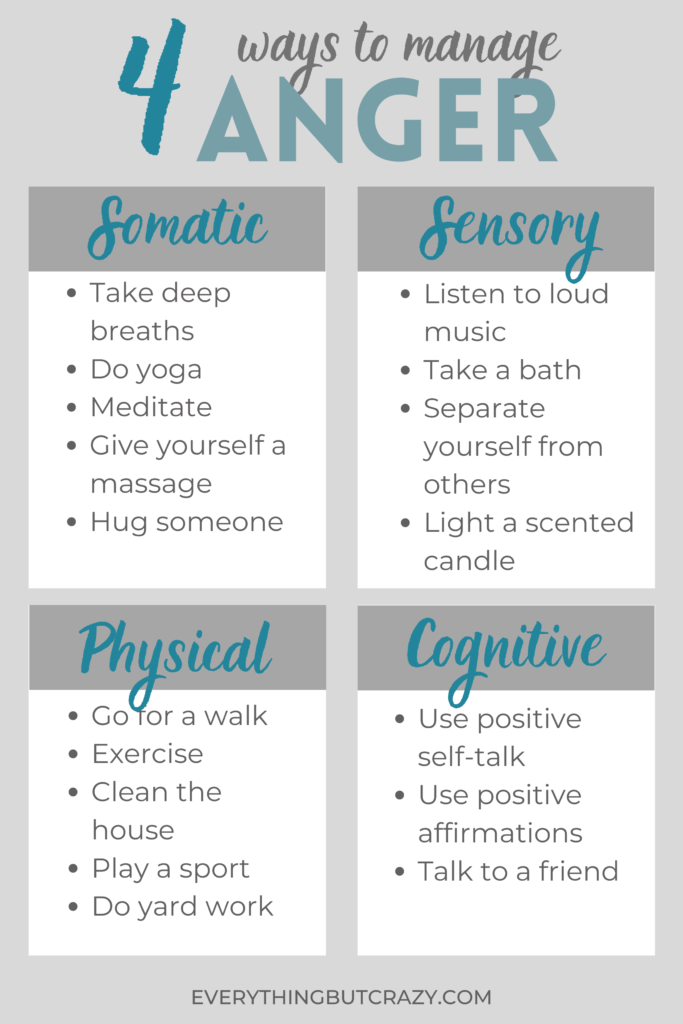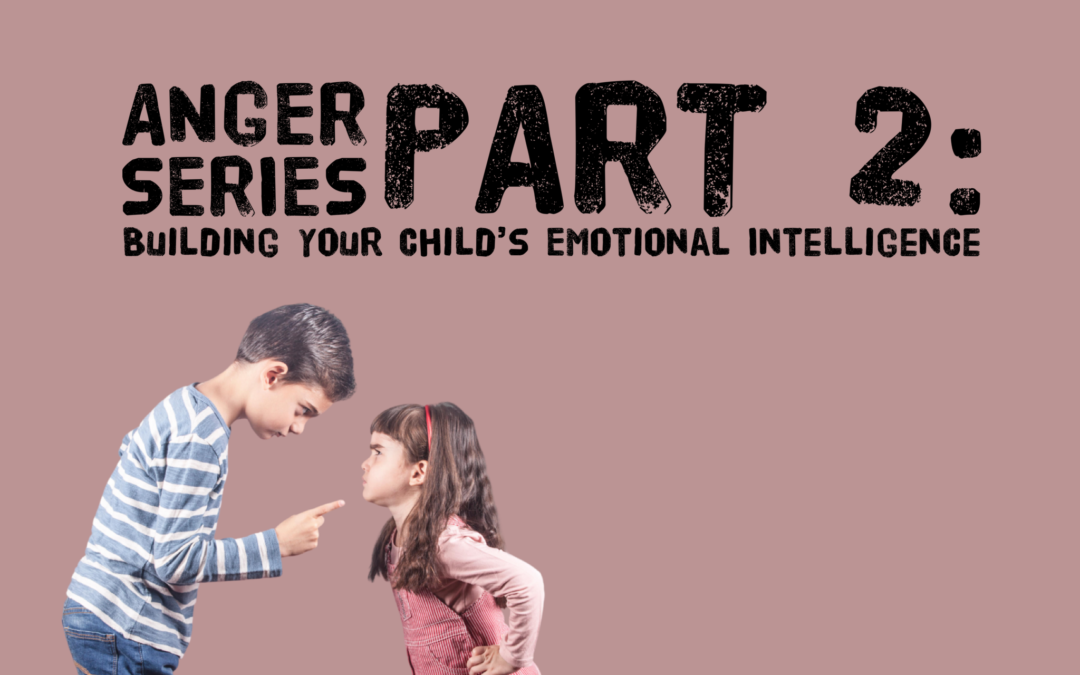Building your child’s emotional IQ is an important component of teaching them to cope with anger.
In my last post I wrote about the importance of preventing unnecessary anger by paying attention to both precipitating events and context (if you haven’t yet read it, you can do so HERE). If you’re like most parents, I’m sure you’re excited to get to the interventions, or the strategies for responding to anger (i.e “the good stuff”).
And though I hate to disappoint, I’m compelled to slow us down one more time. Because most of the work in helping children with anger actually occurs before the child becomes angry. All of these preventative efforts may not feel as important as what we do in response to our child’s anger, but in reality these things are often more important.
Consider the hot-head colleague who runs around the office spouting angry expletives whenever the boss asks for information. Or the father who flies off the handle every time his child makes a mistake on their homework. Or the partner who loses her mind whenever her spouse forgets to turn on the dishwasher.
In each scenario, these individuals seem to be missing some important skills in learning how to manage their emotions. Combining them together, these skills make up something often called emotional IQ (or EQ).
According to Psychology Today, “Emotional intelligence refers to the ability to identify and manage one’s own emotions, as well as the emotions of others” (read more here). While the components of emotional IQ are highly debated, I would argue they can be categorized into four main skills: Identifying and labeling emotions, utilizing emotions, communicating emotions, and regulating emotions. Let’s dive into each of these further.

Identifying and Labeling Emotions
The skill of identifying and labeling emotions is one that occurs internally. It starts with a person’s ability to recognize the physiological sensations that comprise emotions. While this may seem ordinary and unworthy of mention, in my personal life as well as in my work as a therapist, I have witnessed countless numbers of people who somewhere along the line learned to “turn off” their awareness of their feelings. In fact, I myself was given the unspoken message that feelings are unwanted, inwardly trying to will them away and tuning out the wisdom they offered me.
But instead of being bad, feelings are actually incredibly informative (For more depth on this concept, check out What’s Up With All These Feelings? and If You Teach Your Kids One Thing Teach Them This).
Unfortunately we can’t use the information our feelings provide us until we learn to decipher one feeling from another. To do this we need to pay attention to those physiological sensations (i.e. butterflies in the stomach, tension in the neck, racing heart, clenched fists, etc). Each person experiences feelings differently, so for your child to build the skill of emotional identification, he will need to start to see how anger presents for him, and how anxiety shows up in his body.
Your child then needs to pair those physiological sensations with the feeling word, such as “when I feel a volcano inside my tummy and like my head is on fire, that means I’m feeling angry.” (I walk you through how to do this in If You Teach Your Kids One Thing Teach Them This). Pairing the physical sensations with language is an important requisite to the next skill.

Utilizing Emotions
I mentioned earlier that as a child I learned to tune out the wisdom my feelings offered me. That was unfortunate, because emotions truly do offer us an important source of information in helping us to navigate life. Just like road signs, our feelings tell us when to stop, when to go, when to use caution, when to make a u-turn, and so on. If we tune this information out, it’s like driving blindly down the road, unable to take into account the winding of the road, the steepness of the hill, or the presence of other drivers.
Part of emotional IQ is being able to recognize this inner wisdom our feelings offer us and allow it to guide our actions (at least in part). It requires us to un-do the damage of any past lessons in which we were taught to minimize that wisdom.
If you’re unsure whether you were taught any such damaging lessons, try and recall whether you were told any versions of the following messages (and whether you’re now passing them on to your children):
- It’s not a big deal
- You shouldn’t be upset over that
- Toughen up
- Big boys/girls don’t cry
- Suck it up
- Don’t worry about it
- There’s nothing to cry about
If you’ve been told any of these things, or if you’re saying them to your child now, chances are there’s a lot of “tuning out” happening. You’re going to want to go back to step one and focus on paying attention to what’s actually happening, not what anyone thinks “should” be happening. Learn how to do that HERE.
You need to first honor the role of your own emotions so you can honor those of your child (and teach them to do the same).

Communicating Emotions
Once we can notice the physiological sensations and connect them to a feeling word, we are then set up to communicate our emotional experience both to ourselves and others.
The ability to put our experience into language is important to ourselves to make sense of it (ohhh, that’s anger I’m feeling). Because once we label it, it becomes much easier to figure out how to cope with it. It’s similar to our experience with medical problems. If we are constantly chasing individual symptoms, such as a GI doctor for nausea, eye doctor for strained eyes, and primary care doctor for fever, we might miss the larger picture that we have the flu. Once we put all these symptoms together under the label of “flu,” we are much better equipped to take the most efficient steps towards caring for ourselves.
The same thing happens with our emotions. When we can piece together the different physiological sensations of any one feeling and label it appropriately, we can then communicate to ourselves what the problem is, which makes it much easier to identify the best response.
Similarly, when we can communicate our feelings clearly to others, through correct labeling, we are more likely to get a helpful response back. There’s less chance for misinterpretation (i.e. assuming that your child’s bad attitude is due to lack of respect, when it is really because they are feeling overwhelmed), and much more assurance it won’t get ignored all together as can often happen when feelings are only communicated behaviorally.

Regulating Emotions
Regulating our emotions is another way of saying cope. We feel best when we are at a place of peace and stability. Although it is common to experience many different emotions each day, and therefore many different fluctuations in mood, we strive to work through each of those emotions so we can find ourselves back on stable ground.
Take the metaphor of a thermostat. Each of us has a preferred temperature for which we are most comfortable in our homes. If we are lucky enough to have central air systems that regulate the temperature for us, we don’t even have to think much about it. When the temperature outside starts to affect the temperature inside, our central air system will kick in until we are back to our comfortable set point.
And if we don’t have that centralized air system, there are still things we can do to regulate the temperature to get back to the pre-determined place of comfort. Maybe we switch on the window AC unit. Maybe we open all the windows in the house, or maybe we stand in front of the fan for a bit. We have to work a little bit harder, but we still have agency in getting ourselves back to the comfort zone.
The same thing happens with emotional regulation. Once negative feelings pop up, the initial skills of identifying, labeling, and communicating those feelings leads us to be better able to respond in a way that helps us get back to our emotional comfort zone.
For some of us, this process has become so ingrained that our bodies seem to almost automatically lead us to the coping responses that will help calm us down. We might go for a run, call a friend, take some time alone, or write in a journal, all of which can help reduce the intensity of our emotions and bring us closer back to our place of calm.
For those of us new to this skill, we might feel like we are fumbling in the dark, unsure of where to go to feel better. As with most things, trial and error will be an important part of learning what works for YOU (because everyone needs different things). But here are some ideas to get you started:
. 
When you get used to noticing, utilizing, communicating and regulating your feelings, you and your child will be much more equipped to tackle emotion-inducing situations without them incapacitating you. This doesn’t mean you’ll be able to avoid anger completely (remember, this wouldn’t even be desirable as anger serves an important function in our lives!), but it does mean you’ll be able to reduce the amount of situations that lead to full blown anger. So if you’re a parent who is trying to help their child cope with anger, or if you’re wanting to help prevent unnecessary anger, start by helping your child to build these skills. It will pay off.
*note that other feelings and physiological conditions, such as jealousy, hurt, fatigue, and hunger, can also lead to aggressive behavior.
QUICK LINKS:
Anger Series Part 1: Identifying and Preventing Triggers
Anger Series Part 3: Responding to Your Child’s Anger
___
Dana Basu, PsyD is a licensed clinical psychologist at EverGROW therapy and founder of Everything But Crazy, an online resource for parents. She provides individual therapy, support groups, and online resources for parents in Orange County and throughout the state of California via online therapy. She specializes in working with the highly sensitive person and people with difficult childhood experiences, trauma, parenting stress, and chronic guilt.

